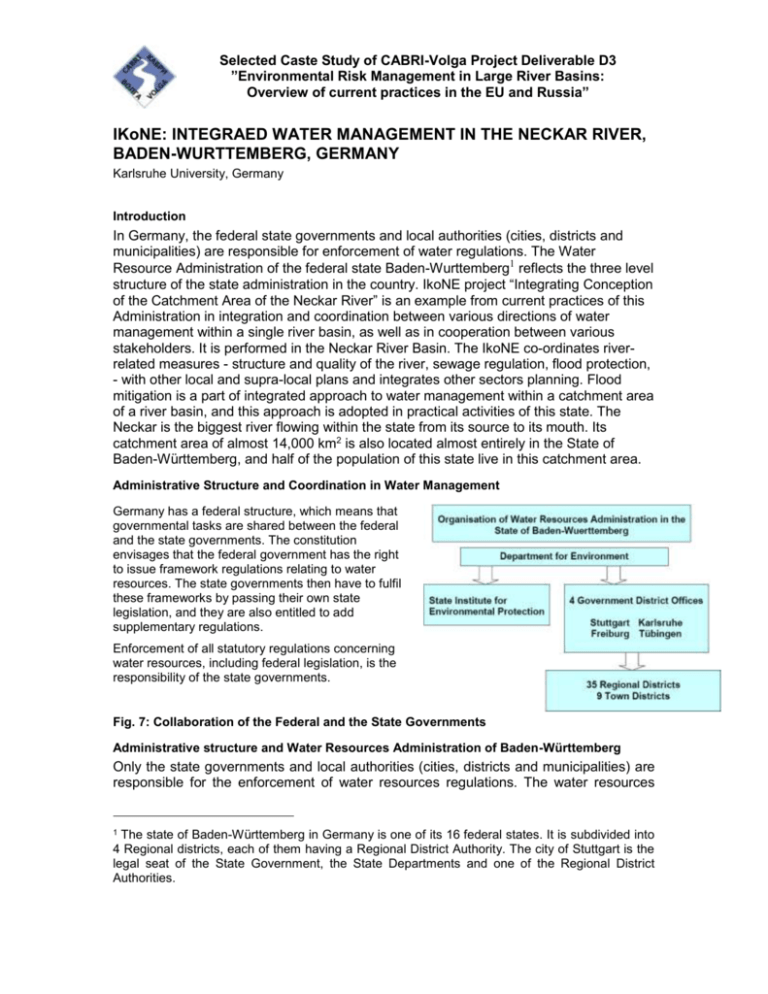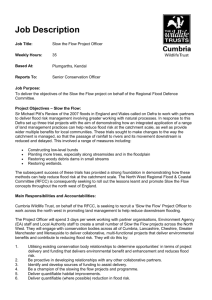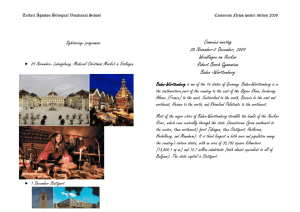IKoNE: INTEGRAED WATER MANAGEMENT IN THE - CABRI
advertisement

Selected Caste Study of CABRI-Volga Project Deliverable D3 ”Environmental Risk Management in Large River Basins: Overview of current practices in the EU and Russia” IKoNE: INTEGRAED WATER MANAGEMENT IN THE NECKAR RIVER, BADEN-WURTTEMBERG, GERMANY Karlsruhe University, Germany Introduction In Germany, the federal state governments and local authorities (cities, districts and municipalities) are responsible for enforcement of water regulations. The Water Resource Administration of the federal state Baden-Wurttemberg1 reflects the three level structure of the state administration in the country. IkoNE project “Integrating Conception of the Catchment Area of the Neckar River” is an example from current practices of this Administration in integration and coordination between various directions of water management within a single river basin, as well as in cooperation between various stakeholders. It is performed in the Neckar River Basin. The IkoNE co-ordinates riverrelated measures - structure and quality of the river, sewage regulation, flood protection, - with other local and supra-local plans and integrates other sectors planning. Flood mitigation is a part of integrated approach to water management within a catchment area of a river basin, and this approach is adopted in practical activities of this state. The Neckar is the biggest river flowing within the state from its source to its mouth. Its catchment area of almost 14,000 km2 is also located almost entirely in the State of Baden-Württemberg, and half of the population of this state live in this catchment area. Administrative Structure and Coordination in Water Management Germany has a federal structure, which means that governmental tasks are shared between the federal and the state governments. The constitution envisages that the federal government has the right to issue framework regulations relating to water resources. The state governments then have to fulfil these frameworks by passing their own state legislation, and they are also entitled to add supplementary regulations. Enforcement of all statutory regulations concerning water resources, including federal legislation, is the responsibility of the state governments. Fig. 7: Collaboration of the Federal and the State Governments Administrative structure and Water Resources Administration of Baden-Württemberg Only the state governments and local authorities (cities, districts and municipalities) are responsible for the enforcement of water resources regulations. The water resources 1 The state of Baden-Württemberg in Germany is one of its 16 federal states. It is subdivided into 4 Regional districts, each of them having a Regional District Authority. The city of Stuttgart is the legal seat of the State Government, the State Departments and one of the Regional District Authorities. Selected Caste Study of CABRI-Volga Project Deliverable D3 ”Environmental Risk Management in Large River Basins: Overview of current practices in the EU and Russia” administration in Baden-Württemberg reflects the three-level structure of the state administration in general. Highest Level: Environmental Department with a section for Water and soil. Tasks: Management of water resources administration and general administrative procedures. Middle Level: Four Regional District Authorities, each of them with a section for pollution control and water resources management. Tasks: Water resources management on a regional basis, significant legal procedures in this sphere, administrative procedures, counselling services, funding of water resources measures taken by cities and amalgamations of cities Lowest Level: This level is formed by 35 districts and by those 9 big cities which constitute districts on their own. Tasks: process water resources legislation, provide specialist advisory services, monitor surface waters and affluent run-off into these ground water protection, water supply sewage/waste water disposal, protection of surface waters waste management, waste treatment techniques surface waters, hydraulic engineering, flood protection land protection, restoration of contaminated sites Selected Caste Study of CABRI-Volga Project Deliverable D3 ”Environmental Risk Management in Large River Basins: Overview of current practices in the EU and Russia” Water supply and sewage disposal are part of the tasks of the municipalities. In order to cover these costs the water-users have to pay contributions and fees to the municipal administrations. They are responsible for the preservation of smaller surface water bodies which they own. In Germany, associations play an important role. Usually voluntary but in part also set up by the Federal State, they are amalgamations of municipalities regulated by contracts. Their task is to manage specific water resources problems exceeding municipal boundaries, e.g. water supply, sewage treatment, preservation of surface waters and flood protection. IKoNE – Integrating Conception of the Catchment area of the Neckar River IKoNE is an example of the activity of the Water Management Administration of BadenWürttemberg. It integrates other partners and coordinates technical procedures in a catchment area - not only for flood protection. The Neckar is the biggest river flowing within the State from its source to its mouth. Its catchment area of almost 14,000 km2 is also located almost entirely in the State of Baden-Württemberg, 50% of the population of this State live in this catchment area. The Minister for Environment of Baden-Württemberg has given the go-ahead for IKoNE in 1999 which consists in a river-basin-related action framework concerning water resources management for the entire catchment area of the Neckar river including its affluents. Thereby planning and acting of water resources management in the catchment area of the Neckar river are provided in a synoptic way, taking into account also the requirements of the European Union framework Directive about water. Significance: •50 % of the resident population of Baden-Württemberg •40 % of the surface of Baden-Württemberg• Land use legend at the right and text of map non readable Selected Caste Study of CABRI-Volga Project Deliverable D3 ”Environmental Risk Management in Large River Basins: Overview of current practices in the EU and Russia” Fig. 8: The Neckar catchment area Basic Idea of IKoNE As action framework concerning water resources management, IKoNE co-ordinates river-related measures - flood protection, structure and quality of the river - with other local and supra-local plans and integrates other sector plannings. The objective is to preserve and improve the rivers as living spaces and lifelines of the landscape as well as important natural factors for business locations. IKoNE addresses citizens, industry and business, associations and authorities, thus all parties living at the Neckar river and its affluents and feeling responsible for this region. In a joint responsibility for today's and future generations, preservation of nature and use by humans have to be brought into harmony. In order to achieve a broad acceptance of the action, the objectives of the water management administration must be anchored into the awareness of the general public. This requires to know about and to understand the complexity of water resources management. IKoNE aims at achieving its objectives basing on the following principles: acting from a synoptic view orientation by joint objectives partnership of all participating parties IKoNE is not construction and investment program, but a tool for preparing the realisation of such programs. Action programs of IKoNE IKoNE defines and bundles the multiple tasks of river management into action programs. This includes measure-related action programs and fundamentally-orientated action programs. The latter serve to gather and make available water resources management data. Within the action programs, the following specialised objectives are formulated: Flood management Management of flood endangered surfaces and catchment areas Technical flood protection Flood damage prevention Quality of the waterway: Target Quality Class II – slightly polluted State-of-the-art sewage installations Structure of the waterway: Eco-morphology Minimum run-off Permeability Selected Caste Study of CABRI-Volga Project Deliverable D3 ”Environmental Risk Management in Large River Basins: Overview of current practices in the EU and Russia” By means of this action programs and the framework conditions which have to be taken into account, conceptions are elaborated for the entire catchment area of the Neckar river and its affluents e.g.: Conceptions for flood protection Conceptions for waterway restoration Conceptions for waterway development On the basis of these conceptions the planning authorities of State and municipalities elaborate concrete action procedures and construction projects. Working methodology of IKoNE Within the work of IKoNE, the concept "integrating" means the following: The entire catchment area is considered. All subjects of water resources management are considered in a synoptic way. The interdisciplinary approach ensures that also other subjects are integrated. The expectations of the population concerning the living space of the river with its recreation and leisure function All partners from within the administration and from outside as well as the task promoters are involved. Besides the traditional administrative work, communication is of special importance within IKoNE. The communication within IKoNE should Present the water resources management with its tasks and objectives in a convincing way. Create confidence. Influence behaviour. Win co-operation partners. IKoNE provides a guiding tool with agreements upon objectives for the catchment area of the Neckar river from which environmental, technical and financial priorities can be deduced. IKoNE is an agenda for politic, administrative, scientific and private action for the sustainable management and development of the waterways in the catchment area of the Neckar river. All responsible and participating parties can use these documents. The IKoNE handbook 4 describes flood management with all its components with the joint objective of reducing flood damages. A tool developed jointly by research and administration within IKoNE which should support the all-encompassing flood management: Selected Caste Study of CABRI-Volga Project Deliverable D3 ”Environmental Risk Management in Large River Basins: Overview of current practices in the EU and Russia” GIS-supported flood modelling by the example of the Neckar river Fig. 9: GIS-supported flood modeling On request of the Water Management Administration of Baden-Württemberg, the Institute of Water Resources Management, Hydraulic and Rural Engineering (IWK) of the University of Karlsruhe has developed in the context of the program IKoNE a GISsupported flood model for the Neckar river. The model is transferred to the water management administration of Baden-Württemberg with the goal of supporting the handling of flood-related issues (determination of legally defined flood areas, analysis of flood protection level, risk analysis etc.). GIS-functionalities and user interfaces that are particularly aligned with the needs of the administration have been developed. In addition, training courses are organised. The project is a positive example of the successful co-operation of the water management administration of the State with research and the waterways and shipping administration of the Federal Government. This network has been substantial for the success of this project. By this means it was possible to create sustainable co-operation relations, a realistic requirement profile for the needs of the water resources administration, an effective data and know-how transfer as well as transparency for all involved parties and users. The model has proved to be very useful: overflow scenarios have been visualised in such a comprehensible and convincing way that municipalities could be induced to take measures for flood protection and damage prevention before a damaging flood took place and not only after having experienced material flood damages.






